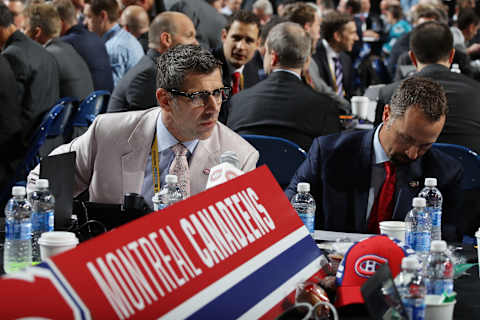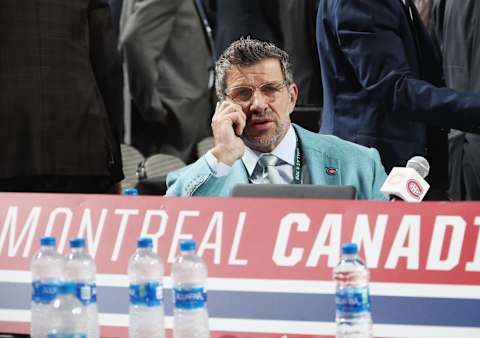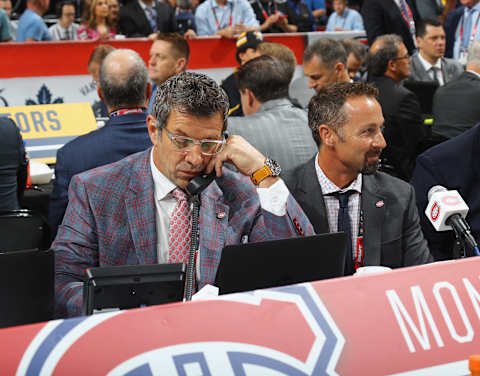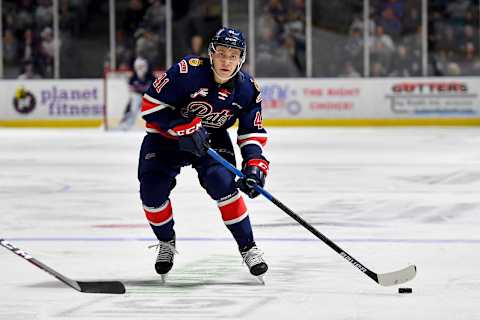9 Players the Canadiens May Consider in Rounds 2-7 of the NHL Entry Draft


While everyone is focused on the first round of the NHL Entry Draft, let us take a look at nine candidates to be drafted by the Montreal Canadiens in later rounds.
The NHL Entry Draft is nearly upon us. The offseason is about to begin. I expect that I am far from the only hockey fan to be obsessively refreshing Twitter to see if any big trades or signings have been made and, more often than not, being left disappointed. I am so very excited for the Draft and for the subsequent free agent frenzy.
However, while most people are, understandably, excited for Round 1 on Tuesday evening, I find myself being more curious to see what happens on Wednesday starting at 11:30 AM EST: rounds 2 through 7 of the draft. The hype is far less extreme, but it is on this day that teams can really flesh out their rosters for years to come with solid non-superstars. Of course, some superstars do drop to the later rounds, but they are few and far between, the real value is to be had among solid mid-roster players like in the ilk of Joel Edmundson and Ben Chiarot (former second and fourth-round draft picks respectively).
Frederik Andersen and Braden Holtby were 3rd and 4th-round picks respectively and have since carved out more than stellar NHL careers; while forwards like Brendan Gallagher (5th-round), Kevin Labanc (6th round) and Tyler Bertuzzi (2nd round) have become top-6 players. It must be acknowledged that the vast majority of draft picks between rounds 2 and 7 do not reach the NHL, let alone forge a career in the league, but this makes it all the more exciting to uncover these hidden gems.
While I have tried to watch at least 3 or 4 games of the projected first-round picks of the 2020 NHL Entry Draft, I have not been able to do the same for the late-round prospects. Therefore, the players I have identified in this article are a result of my reading the Elite Prospects 2020 Draft Guide which details their top-129 prospects with game reports and between 1 and 2 pages of analysis of each player. Despite this Draft Guide being my primary source of information, I have also looked at at least two other sources for the nine players I have outlined to try to negate any bias. Plus, the players I liked the profile of aren’t necessarily ones that Elite Prospects loved.
Anyway, enough of my babbling, let us jump into the nine players that I would love to see picked by the Canadiens on Wednesday afternoon.

Tristen Robins, C/RW, Saskatoon Blades, WHL, 5’11”, 183lbs, 2nd round.
Tristen Robins is a November-born forward who produced 33 goals and 73 points in 62 WHL games this past season. Most outlets project him to be selected between picks 51 and 63. This means that Marc Bergevin may have three opportunities to pick him in the second round, as the Canadiens possess picks 47, 48 and 56, but Robins will likely be off the board by the time pick 77 (Montreal’s third-round selection) comes around.
Robins is a high-energy player with a very refined offensive mind, great anticipation and good stickhandling. This stickhandling is enhanced by his deceptive abilities, though his slight lack of speed limits this particular area of his game. Robins can shoot too, with a versatile release, he can score from even awkward positions. He is a capable distributor as well, with good vision and while his playmaking abilities are not elite, he picks his passes carefully and makes them count, often setting up teammates in prime scoring positions.
What makes Robins so intriguing to me, however, is that he has a Brendan Gallagher-esque nose for the net. He loves to get to the dirty areas and bang in rebounds and be an all-around nuisance for opposing goaltenders and defenders. While Robins may not be a perennial 30-goal scorer in the NHL like Gallagher, he has the potential to become a dual-threat scorer in the top-6 of an NHL team someday, maybe maxing out at 25 goals and 35 assists in a season while being an absolute pest for opposing players.
At this stage of the draft, that kind of potential, that actually has a decent chance of being fulfilled, is very enticing.
Daniil Gushchin, RW, Muskegon Lumberjacks, USHL, 5’8″, 161 lbs, 2nd to 3rd round.
Daniil Gushchin possesses a rare combination, he is a diminutive winger who is highly skilled but also has a very high work rate and is really good defensively. A combination that is sure to catch the eye. Let us start with his offensive abilities.
Gushchin produced 22 goals and 47 points in 42 USHL games. He possesses a very powerful shot that lacks accuracy, but if this can be refined by the development team that drafts him, he could become a potent goalscorer. While he does have a nice playmaking skill-set, it is his stick-handling that steals the show. He is patient, smart and deceptive on the puck and can maneuver his way through very tight situations all while maintaining control of the puck. This skill can take control of a game and create very dangerous scoring opportunities both for himself and for his teammates.
This offensive toolkit is not necessarily a rarity amongst Russian wingers, but when you throw in his defensive play and his embracement of physical play despite his small stature, you have an intriguing prospect. Gushchin is a fearless forechecker and this ferocity is quite often rewarded with offensive zone turnovers. He is also a committed back checker.
What I find so alluring about Gushchin is that he is a rare high-ceiling, high-floor prospect projected to be available beyond the first round (in the 40 to 65 range, to be precise). While his high-end skill and powerful shot could make him a reliable top-6 RW in the future, even if the necessary development for that to occur does not, Gushchin has the ability to become a high-end third-liner who has a positive impact at both ends of the ice. Gushchin will play this upcoming season in the OHL with the Niagara Ice Dogs, where he will likely pile up a ridiculous amount of points.

Sam Colangelo, RW, Chicago Steel, USHL, 6’2″, 207 lbs, 2nd to 3rd round.
Sam Colangelo addresses a need of the Montreal Canadiens, he is big, he’s a right-winger and he can score. He is projected to be picked in the same range as Gushchin, so 40-65. He played on a dominant Chicago Steel USHL team and had Brendan Brisson (Pat Brisson’s son and a projected 1st-round draft pick) and Sean Farell (projected 3rd-round pick) as linemates. Colangelo put up 28 goals and 58 points in 44 games.
Colangelo is a gritty power forward who, aside from possessing a dangerous shot and a great playmaking ability, is very good defensively, playing a key role on both the powerplay and penalty kill on that stacked Chicago Steel team. Colangelo is also not a passenger on that top line, he drives the play. He is a smart and physical player who could become a high-end Swiss army knife type player.
Colangelo’s sole detractor is his skating. He possesses a slow and slightly clumsy stride. Were it not for this, he would be a sure-fire first-round pick, so selecting him is taking a gamble on his ability to refine this area of his play; even if he just becomes an NHL-average skater, he could very well find himself as a Joel Armia type 3rd liner and his ceiling could resemble that of an Alex Tuch, as Marco D’Amico from Scrimmage and Stats pointed out in his final prospect ranking.
Anton Johannesson, LD, HV71, J20 SuperElit, 5’9″, 154 lbs, 2nd to 3rd round.
Anton Johannesson may be small, but that small frame packs quite the punch. The Swedish defenceman played last season in the under-20 SuperElit and was a regular defensive partner of Emil Andrae, who may be a first-round selection in this year’s draft. While Andrae is an all-out offensive defenceman who struggles defensively, Johannesson produces just as much, if not more, offence while also being competent defensively.
Johannesson led all defencemen in the J20 SuperElit in points/game with 1.2. He scored 8 goals and 24 points in 20 games. It must be noted that most defencemen played around 40 games, which Johannesson missed out on due to injury, but when he got on the ice, he produced. Since 1995, only one defenceman to have played at least 15 games has recorded a higher points/game total than Johannesson in a J20 SuperElit season, and that was a certain Erik Brannstrom, who put up 23 points in 19 games, or 1.21 points/game.
Johannesson is a very creative playmaker and distributor in the offensive zone, his high-level vision and his deceptive abilities make him a constant offensive threat when the puck is on his stick. He is also very mobile, which is a necessity given his diminutive stature. On the defensive side of things, Johannesson is very good at preventing controlled zone entries against, in other words, he protects his blue line very well. He is also more than competent in 1-on-1 defensive situations.
Where Johannesson struggles is during sustained play in his own zone. This, however, can be taught, if he learns to be less passive in these situations and improve his gap-control, he could become a decent defensive piece. The one thing Johannesson will never be, though, is physical. He is not one of those small players like Daniil Gushchin who relishes physical play. All in all, though, Johannesson has a high offensive potential, and could very well become a point-producing top-4 NHL defenceman, he just needs a few more years of development.

Wyatt Kaiser, LD, Andover Huskies, USHS Minnesota, 5’11”, 170 lbs, 3rd to 7th round
Wyatt Kaiser is an exceptionally quick, smooth-skating defenceman who is great in transition. In other words, a very modern defenceman. Point-production is not the name of the game for Kaiser, despite the 34 points he accumulated through 25 games; he played for the dominant team in the Minnesota High School league, and defencemen have been known to produce up to 3 points/game in the league in the past.
Kaiser lacks a really threatening shot from the point, but, what he will do offensively, is to frequently join the rush and drive up the middle of the ice and crash the net, he is rarely forced to the periphery. This creates rebounds and all-around mayhem for the opposing defence and goaltender. While he is a great skater and can easily take the puck up the ice himself, he can also make pin-point breakout passes to start a quick counter-attack.
Kaiser is a very calm player who is always aware of his surroundings and is solid in his own zone but does not steal the show defensively. The main drawback to his game is that he can make 1-2 big mistakes every game, these lapses in concentration come out of nowhere since his game is mostly refined and composed. This will need to be refined by whichever development team drafts him, but there is a really nice foundation in this player to become a solid second-pairing transitional defenceman.
Albert Lyckasen, RD, Linkoping, J20 SuperElit, 5’11”, 187 lbs, 6th to 7th round.
Lyckasen is a draft re-entry, having gone undrafted last year; he should face a different outcome this time around. He is a modern transitional defenceman who can pile up the points with his high-end playmaking ability. Just like Johannesson, he played this past season in the J20 SuperElit and he finished second in the league in scoring for defencemen with 14 goals and 36 points in 43 games, just two points behind Emil Andrae, he did, however, lead the charge in goals scored by defencemen, with 3 more than the runner-up. Lyckasen was 6th amongst league defencemen in terms of points/game with 0.84. Lyckasen’s 14 goals put him in 10th among top goalscoring defencemen in league history.
Despite his goalscoring achievements, Lyckasen is likely to be a playmaker, first and foremost at the next level, as his shot is average while his passing ability is well above average. Lyckasen is an exciting skater to watch, he has great mobility and speed and his stride seems effortless at times. He is at his best with the puck on his stick as he is a constant passing threat and possesses good puck skills and deception to manipulate defenders in the offensive zone.
He is a very good transporter of the puck and can both skate it up the ice himself and make an accurate outlet pass to a teammate. Defensively, he gets the job done, but his defensive play is not the reason he should be drafted this year, that would be his great skating ability, his value in transition and his playmaking. Lyckasen has the potential to develop into a transitional #4 defenceman at the NHL-level; he will be playing next season in the Allsvenskan, I see a similar career path to that of Mattias Norlinder, despite Lyckasen’s lower offensive potential to his Swedish compatriot.

Benjamin Baumgartner, C, HC Davos, Swiss NL League, 5’9″, 165 lbs, 5th-7th round.
Drafting Benjamin Baumgartner would be a Hail Mary selection. This is the third draft he has been eligible for and he is 20 years old, but he produced 7 goals and 27 points in 37 games against men in Switzerland. The Austrian forward put up one more point than former #1 Habs centreman, David Desharnais in the league this past season. Baumgartner is a home-run swing because the chances of him forging a spot in the bottom-6 of an NHL lineup are minimal, but if he pans out, he could be a top-6, play-driving playmaker.
Baumgartner possesses silky-smooth stick handling, which plays an important role in his play on the puck in the offensive zone, he has the ability to retain possession of the puck in the offensive zone for extended periods of time, patiently waiting for the perfect opportunity to strike. When he strikes, it rarely comes in the form of a shot, as he lacks a threatening quick release; he does, however, have a great playmaking ability. The Elite Prospects Draft Guide described him as a highly capable distributor who is a great problem-solver, is very deceptive on the puck, can manipulate his opponents and who possesses dextrous hands, high-end vision and technically-sound passing.
At this stage of the draft, Marc Bergevin may opt to take a home-run swing on a player like Baumgartner, who, in all likelihood will not make the NHL, but who, if he were to make his way to the top league in the world, could become a high-end playmaking top-6 centre. The Canadiens’ prospect pool is full of players who have a decent chance at becoming 4th liners or 3rd pairing defencemen, why not take a late-round risk?
Jonny Meiers, LW, Eagan High, USHS Minnesota, 5’9″, 174 lbs, Unranked
Jonny Meiers may not be ranked by any scouting outlet other than Elite Prospects, who have him at 117, but I would be surprised if he were to go undrafted, his profile is just so promising. Meiers can play any forward position and can play in all situations. He has great mobility despite a slightly inefficient skating stride and is very pacy in transition and dangerous off the rush.
Elite Prospects describes his play as a “tenacious, buzz-saw like game, with unyielding pace and battle level.” So Meiers is a quick, hard-working player who is a decent skater; good start. He is deceptive on the puck and has a very low centre of gravity, so despite his diminutive frame, he is difficult to knock off the puck. He will not produce 40 points even if he reaches his potential in the NHL, but he will play a game akin to that of Artturi Lehkonen, a high-energy, forechecking forward who excels defensively.
In his own zone, Meiers sports great anticipation and decision making, which make him a reliable penalty killer. Despite his size, Meiers plays a physical game, laying many hits on opposing players; he also seeks out the dirty areas of the ice to pester his opposition and to create opportunities for “garbage goals”. For someone who could be on the board in the last round or two, Meiers could be a real steal.

Alexei Goryachev, LD, Loko Yaroslavl, MHL, 6’1″, 187 lbs, Unranked.
I really, really like this player; I mean, he’s 12th in my ranking of 2020 draft-eligible defencemen, ahead of high-profile players like William Wallinder, Lukas Cormier and Topi Niemiela. Goryachev is an Alexei Emelin-type player with, perhaps, a higher defensive potential. He is supremely physical, throwing some truly devastating hits. However, Goryachev is not one to go out of his way to make a hit, but if the opportunity presents itself, he hits big.
The Russian defenceman is great defensively, too. He is an aware, aggressive and active defender with a high-churning motor; he also closes gaps very quickly. Goryachev is far more proactive defensively than many of the defensemen that will hear their names called at the draft. Goryachev has the ability to kill offensive plays with this skillset and is extremely reliable in his own zone.
His offensive potential is limited, so if he makes the NHL, it will likely be in a shutdown role on the second or third pairing. While he can’t be classified as a puck-moving defenceman, the raw tools are there for him to become a decent piece in transition and to reach NHL-average mobility. For a player who could very well still be available in the 7th round, Goryachev has a really promising skillset, one that resembles a mashup of Ben Chiarot and Alexei Emelin with a higher defensive potential than both of them; he could be a very fun player to watch.
Honourable Mentions in No Particular Order
- Daniel Torgersson, RW, Frolunda, J20 SuperElit, 6’3″, 205 lbs, 2nd-3rd round. A skilled, big, defensively-responsible power-forward in the mould of Patrik Hornqvist, camps in front of the net, forechecks, backchecks, finds open space in the offensive zone.
- Ryker Evans, LD, Regina Pats, WHL, 5’11”, 181 lbs, 5th-6th round. A defenceman that can do it all at a good level, transition, offence, defence, all situations. His draft stock was hurt by the terrible team that surrounded him, similarly to Cale Fleury in his draft year.
- Declan Carlile, LD, Merrimac College, NCAA, 6’2″, 190 lbs. A big, physical 20-year-old shutdown defenceman who played monster minutes in the NCAA as a freshman, can play all situations, blocks shots, great defensively, skating needs refinement.
- Brandon Coe, RW, North Bay Battalion, OHL, 6’3″, 185 lbs. Intelligent two-way power-forward, plenty of skill, just needs to put it all together, smart, great defensively, above-average speed, soft hands, gets forced to the perimeter. Could become like Joel Armia.
Conclusion
There are so many prospects that I like a whole lot that will be available between rounds 2 and 7 on Wednesday, I easily could have made the honourable mentions list 15 players long. But the 9 players covered in this article and the 4 that made the honourable mentions are among my very favourites.
I did not focus on the Canadiens’ positional needs for the players in this article, as is made clear by the 5 LD’s that made the final cut of 13 players. I think that if a team has a prospect pool as deep as the Canadiens’, drafting the best player available is a sound approach, and it simply turned out that a fair few RW power forwards and LD’s may slip further than they should in my eyes.
The Canadiens have 11 draft picks in the 2020 NHL Entry Draft at the time of writing and I am very interested to see what they do with them. Be it trade them for help now, draft the best player available at every slot or draft for positional need (RD, LW, RW), I am sure that the upcoming days and the draft itself will be particularly entertaining this year.